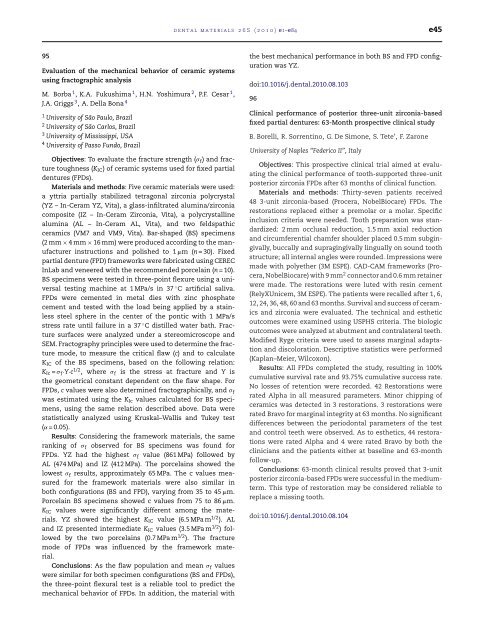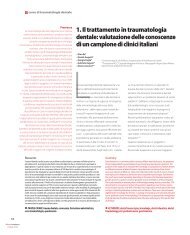Abstracts of the Academy of Dental Materials Annual ... - IsiRed
Abstracts of the Academy of Dental Materials Annual ... - IsiRed
Abstracts of the Academy of Dental Materials Annual ... - IsiRed
You also want an ePaper? Increase the reach of your titles
YUMPU automatically turns print PDFs into web optimized ePapers that Google loves.
95<br />
Evaluation <strong>of</strong> <strong>the</strong> mechanical behavior <strong>of</strong> ceramic systems<br />
using fractographic analysis<br />
M. Borba 1 , K.A. Fukushima 1 , H.N. Yoshimura 2 , P.F. Cesar 1 ,<br />
J.A. Griggs 3 , A. Della Bona 4<br />
1 University <strong>of</strong> São Paulo, Brazil<br />
2 University <strong>of</strong> São Carlos, Brazil<br />
3 University <strong>of</strong> Mississippi, USA<br />
4 University <strong>of</strong> Passo Fundo, Brazil<br />
Objectives: To evaluate <strong>the</strong> fracture strength ( f) and fracture<br />
toughness (KIC) <strong>of</strong> ceramic systems used for fixed partial<br />
dentures (FPDs).<br />
<strong>Materials</strong> and methods: Five ceramic materials were used:<br />
a yttria partially stabilized tetragonal zirconia polycrystal<br />
(YZ – In-Ceram YZ, Vita), a glass-infiltrated alumina/zirconia<br />
composite (IZ – In-Ceram Zirconia, Vita), a polycrystalline<br />
alumina (AL – In-Ceram AL, Vita), and two feldspathic<br />
ceramics (VM7 and VM9, Vita). Bar-shaped (BS) specimens<br />
(2 mm × 4mm× 16 mm) were produced according to <strong>the</strong> manufacturer<br />
instructions and polished to 1 �m (n = 30). Fixed<br />
partial denture (FPD) frameworks were fabricated using CEREC<br />
InLab and veneered with <strong>the</strong> recommended porcelain (n = 10).<br />
BS specimens were tested in three-point flexure using a universal<br />
testing machine at 1 MPa/s in 37 ◦ C artificial saliva.<br />
FPDs were cemented in metal dies with zinc phosphate<br />
cement and tested with <strong>the</strong> load being applied by a stainless<br />
steel sphere in <strong>the</strong> center <strong>of</strong> <strong>the</strong> pontic with 1 MPa/s<br />
stress rate until failure in a 37 ◦ C distilled water bath. Fracture<br />
surfaces were analyzed under a stereomicroscope and<br />
SEM. Fractography principles were used to determine <strong>the</strong> fracture<br />
mode, to measure <strong>the</strong> critical flaw (c) and to calculate<br />
KIC <strong>of</strong> <strong>the</strong> BS specimens, based on <strong>the</strong> following relation:<br />
KIc = f·Y·c 1/2 , where f is <strong>the</strong> stress at fracture and Y is<br />
<strong>the</strong> geometrical constant dependent on <strong>the</strong> flaw shape. For<br />
FPDs, c values were also determined fractographically, and f<br />
was estimated using <strong>the</strong> KIc values calculated for BS specimens,<br />
using <strong>the</strong> same relation described above. Data were<br />
statistically analyzed using Kruskal–Wallis and Tukey test<br />
(˛ = 0.05).<br />
Results: Considering <strong>the</strong> framework materials, <strong>the</strong> same<br />
ranking <strong>of</strong> f observed for BS specimens was found for<br />
FPDs. YZ had <strong>the</strong> highest f value (861 MPa) followed by<br />
AL (474 MPa) and IZ (412 MPa). The porcelains showed <strong>the</strong><br />
lowest f results, approximately 65 MPa. The c values measured<br />
for <strong>the</strong> framework materials were also similar in<br />
both configurations (BS and FPD), varying from 35 to 45 �m.<br />
Porcelain BS specimens showed c values from 75 to 86 �m.<br />
KIC values were significantly different among <strong>the</strong> materials.<br />
YZ showed <strong>the</strong> highest KIC value (6.5 MPa m 1/2 ). AL<br />
and IZ presented intermediate KIC values (3.5 MPa m 1/2 ) followed<br />
by <strong>the</strong> two porcelains (0.7 MPa m 1/2 ). The fracture<br />
mode <strong>of</strong> FPDs was influenced by <strong>the</strong> framework material.<br />
Conclusions: As <strong>the</strong> flaw population and mean f values<br />
were similar for both specimen configurations (BS and FPDs),<br />
<strong>the</strong> three-point flexural test is a reliable tool to predict <strong>the</strong><br />
mechanical behavior <strong>of</strong> FPDs. In addition, <strong>the</strong> material with<br />
dental materials 26S (2010) e1–e84 e45<br />
<strong>the</strong> best mechanical performance in both BS and FPD configuration<br />
was YZ.<br />
doi:10.1016/j.dental.2010.08.103<br />
96<br />
Clinical performance <strong>of</strong> posterior three-unit zirconia-based<br />
fixed partial dentures: 63-Month prospective clinical study<br />
B. Borelli, R. Sorrentino, G. De Simone, S. Tete’, F. Zarone<br />
University <strong>of</strong> Naples “Federico II”, Italy<br />
Objectives: This prospective clinical trial aimed at evaluating<br />
<strong>the</strong> clinical performance <strong>of</strong> tooth-supported three-unit<br />
posterior zirconia FPDs after 63 months <strong>of</strong> clinical function.<br />
<strong>Materials</strong> and methods: Thirty-seven patients received<br />
48 3-unit zirconia-based (Procera, NobelBiocare) FPDs. The<br />
restorations replaced ei<strong>the</strong>r a premolar or a molar. Specific<br />
inclusion criteria were needed. Tooth preparation was standardized:<br />
2 mm occlusal reduction, 1.5 mm axial reduction<br />
and circumferential chamfer shoulder placed 0.5 mm subgingivally,<br />
buccally and supragingivally lingually on sound tooth<br />
structure; all internal angles were rounded. Impressions were<br />
made with polye<strong>the</strong>r (3M ESPE). CAD-CAM frameworks (Procera,<br />
NobelBiocare) with 9 mm 2 connector and 0.6 mm retainer<br />
were made. The restorations were luted with resin cement<br />
(RelyXUnicem, 3M ESPE). The patients were recalled after 1, 6,<br />
12, 24, 36, 48, 60 and 63 months. Survival and success <strong>of</strong> ceramics<br />
and zirconia were evaluated. The technical and es<strong>the</strong>tic<br />
outcomes were examined using USPHS criteria. The biologic<br />
outcomes were analyzed at abutment and contralateral teeth.<br />
Modified Ryge criteria were used to assess marginal adaptation<br />
and discoloration. Descriptive statistics were performed<br />
(Kaplan–Meier, Wilcoxon).<br />
Results: All FPDs completed <strong>the</strong> study, resulting in 100%<br />
cumulative survival rate and 93.75% cumulative success rate.<br />
No losses <strong>of</strong> retention were recorded. 42 Restorations were<br />
rated Alpha in all measured parameters. Minor chipping <strong>of</strong><br />
ceramics was detected in 3 restorations. 3 restorations were<br />
rated Bravo for marginal integrity at 63 months. No significant<br />
differences between <strong>the</strong> periodontal parameters <strong>of</strong> <strong>the</strong> test<br />
and control teeth were observed. As to es<strong>the</strong>tics, 44 restorations<br />
were rated Alpha and 4 were rated Bravo by both <strong>the</strong><br />
clinicians and <strong>the</strong> patients ei<strong>the</strong>r at baseline and 63-month<br />
follow-up.<br />
Conclusions: 63-month clinical results proved that 3-unit<br />
posterior zirconia-based FPDs were successful in <strong>the</strong> mediumterm.<br />
This type <strong>of</strong> restoration may be considered reliable to<br />
replace a missing tooth.<br />
doi:10.1016/j.dental.2010.08.104



